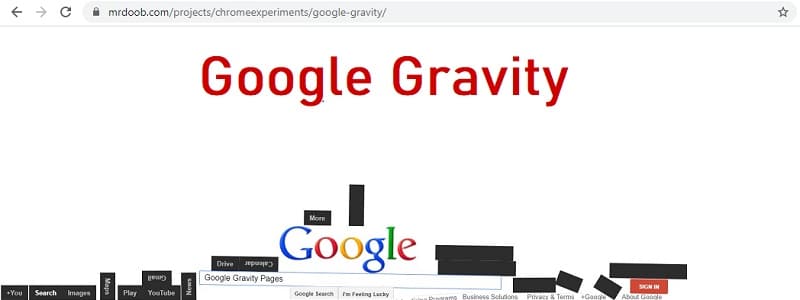
Īir Resistance Despite the fact that all objects are supposed to fall at the same rate, you know that this is not always the case. The two falling objects in the figure on the right demonstrate this principle.

#GRAVITY GOOGLE FREE#
While it may seem hard to believe at first, all objects in free fall accelerate at the same rate regardless of their masses. After two seconds, its velocity is 19.6 m/s (9.8 m/s + 9.8 m/s) The velocity continues to increase as the object falls. After one second, its velocity has increased to 9.8 m/s. For example, suppose an object is dropped from the top of a building at a starting velocity of 0 m/s. įree Fall Near the surface of Earth, this acceleration due to gravity is 9.8 m/s 2. Do you know why? In free fall, the force of gravity is an unbalanced force, which causes an object to accelerate. įree Fall When the only force acting on an object is gravity, the object is said to be in free fall. As the mass of the object increases, so does the pull of gravity but the acceleration is less. Ī cool thing about gravity is that it acts through objects.įorce = Mass x Acceleration (aka: Newton’s 2 nd Law of Motion) As the mass of a moving object decreases, so does the pull of gravity but the acceleration of the object is greater.

What direction is Gravity? Earth’s gravity acts downward toward the center of the Earth. You are attracted not only to Earth but also to all the other objects around you. This means that any two objects in the universe, without exception, attract each other. The law of universal gravitation states that the force of gravity acts between all objects in the universe. Law of Universal Gravitation What Newton realized is now called the law of universal gravitation.

It is the force that keeps all the planets in our solar system orbiting around the sun. It is the force that keeps the moon orbiting around Earth. It is the force that makes an apple fall to the ground. Universal Gravitation Newton realized that gravity acts everywhere in the universe, not just on Earth. Two factors affect the gravitational attraction between objects: mass and distance. Gravity is a force that acts between any 2 masses.

#GRAVITY GOOGLE ANDROID#
3D, A-frame, ARCore, Actions on Google, Android Live Wallpaper API, Android NDK, Android SDK, Android Things, Apps Script, Arduino, Augmented Reality, Blender, CLIP, Canvas, Canvas Quiz, Captive Portal, Cardboard SDK, Cast API, Cinder, Cloud Text-to-Speech API, Convnet.js, D3.js, Demoscene, Dialogflow, Firebase, Framer Motion, GAN, GLSL, GPT-2, Gamepad API, Google Assistant, Google Assistant SDK, Google Cloud AI, Google Cloud Speech API, Google Cloud Vision API, Google Maps Tile API, Google Natural Language, Google Sheets, Handwriting Recognition, Haxe, Javascript, Keras.js, Kotlin, Kotlin, LIT, Machine Learning, Magenta, Magenta.js, Mapbox GL, Maps Places API, MaryTTS, NLP, Nearby API, Nearby API, Node.js, Notification Access API, OpenCV, OpenGL, Opengl, P5.js, Paper.js, Particles, Pixi.js, Polymer, PoseNet, Potree, Processing, Raspberry Pi, React, React Map GL, Shadercam, Speech Synthesis API, Tango, Teachable Machine, TensorFlow, TensorFlow Lite, TensorFlow Lite for Microcontrollers, Tensorflow, Tensorflow.js, Three.js, Tone.js, Torch, Touch Designer, Translate API, USB OTG, Unity, Visualization, Vuforia, Wavenet, Web Audio API, Web Speech API, WebGL, WebMIDI, WebRTC, WebXR, Websockets, Wekinator, es6, ink.js, openFrameworks, react.js, t-SNE, tensorflow.Do Now: What are the 4 types of friction?


 0 kommentar(er)
0 kommentar(er)
